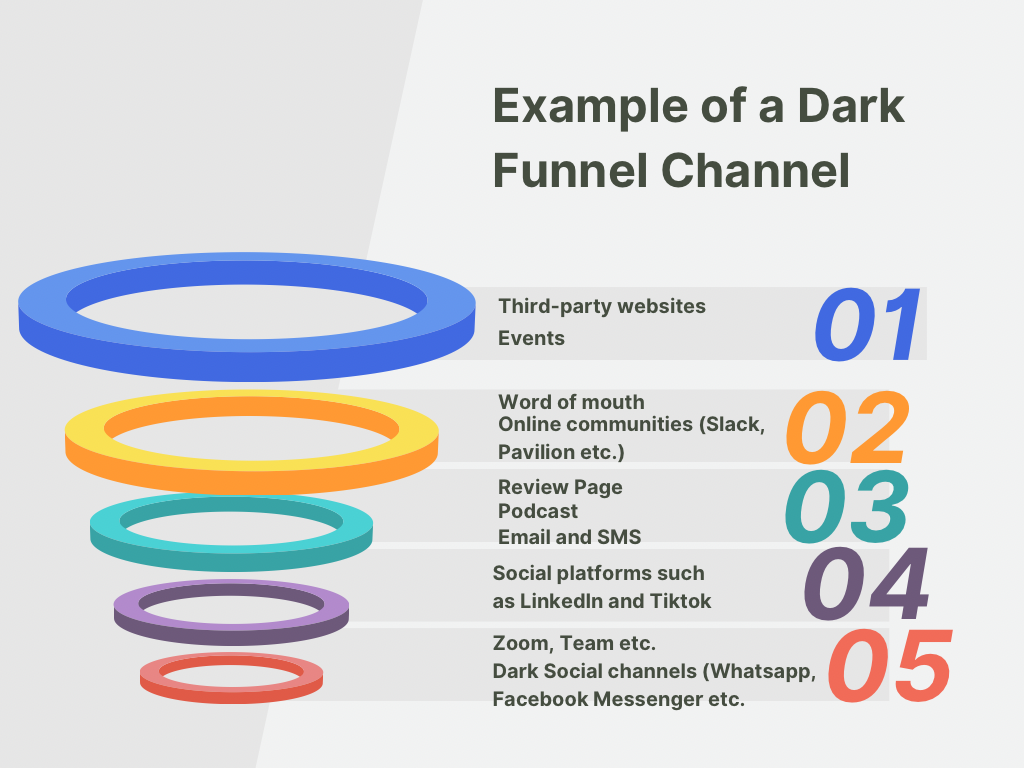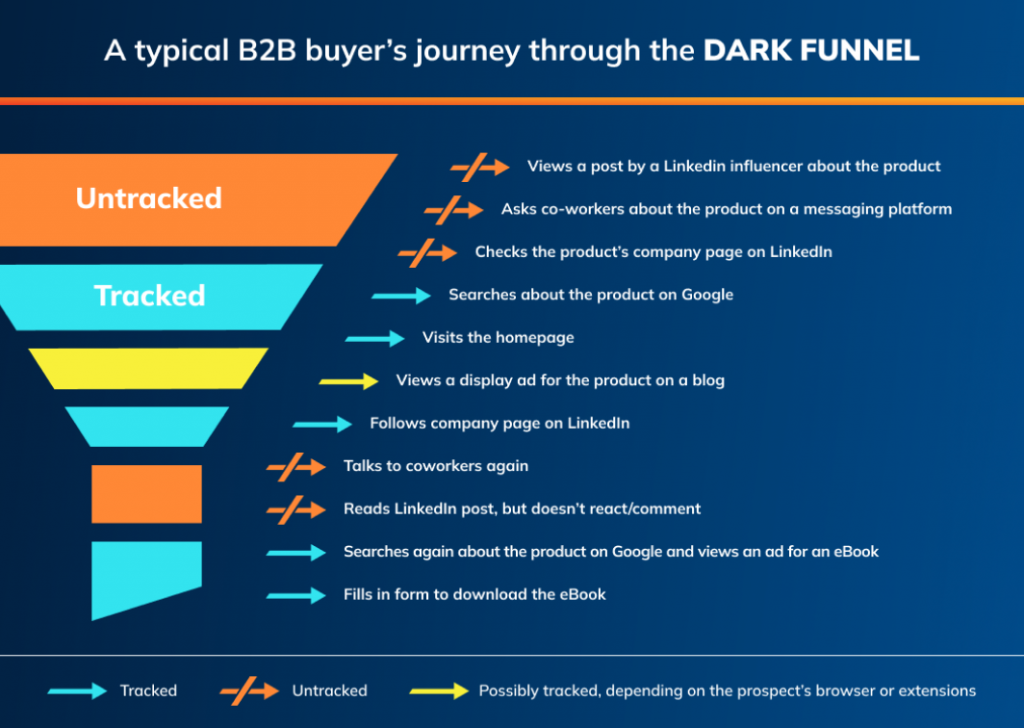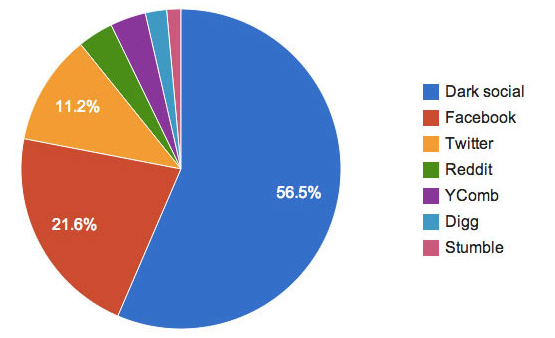Shedding Light on the Dark Funnel: Definition and Roadmap
To understand how the Dark Funnel works, we need to go back to the basics. Marketing funnels are strategically designed to maximize brand recognition and ensure that prospects are being provided with relevant information at each touchpoint. After all, the main idea is to grab as many leads as possible and then nurture them into paying customers.
Marketers often focus on understanding customer behaviour. They make inferences about the customer journey based on what they can see in the analysis. However, there are many things that marketers may not be able to see on this journey. These hidden insights are referred to as the “dark funnel”.
In this article, I will talk about the dark funnel and give you ways to uncover it for your business.

What is the Dark Funnel?

The dark funnel is a concept that has been making rounds in marketing and sales circles. The term refers to what marketing professionals might fail to uncover about their audience, despite their best efforts.
Now, you’re probably wondering, isn’t everything accounted for in this era of digital marketing? After all, everything from clicks and conversions to bounce rates and session durations can be measured.
While it’s true that digital marketing has uncovered a world of information on consumer actions, there are still certain factors, like visits to other sites, and the impact of social media posts and forums might be hidden from marketers.
The dark funnel is basically the blind spot of the customer journey that is hard to track. Some of these behaviours that marketers find valuable, such as visits to other websites, research undertaken through third-party sites, and the influence of social media on purchasing decisions may be hidden from view.
Now, as the number of social platforms increases, it’s becoming even harder to figure out who is engaging with your brand in the shadows.
Here is an example of a dark funnel channel:

What do Marketers Need to Know about the Dark Funnel?

The Dark Funnel enables marketers to get a better understanding of customer interactions. By studying dark funnel behavior, marketers can identify how consumers interact with brands and make purchases, as well as the best ways to stay relevant through marketing planning, content creation and distribution decisions.
Dark Funnel is neither a new tactic nor a replacement for traditional analysis. This is an additional lens for marketers to see and understand their customers.
This additional insight into customer behaviour and motivation helps you make more effective decisions about strategy, messaging, and content creation.
While there are several ways to approach the dark funnel, it’s best to hear what you need to know straight from the users themselves. You can create a survey that asks where your lead heard about you. People will use a number of sources to find your company, and you might not even have considered some of the channels that leads found you through. Knowing about these channels will allow you to improve your visibility and increase the chances of attracting more leads. So, based on the information you receive, you’ll be able to help shape your funnel to better optimize those sources for customer acquisition.
So how can you make dark funnel analytics part of your marketing strategy?
If you understand how people find your website, hear about your podcast, or read one of your blogs, you can develop much more effective strategies to drive and maximize interest. Using the information extracted from your efforts to uncover the dark funnel and analyzing existing customer behavior through tools like Hockeystack, you will be able to get a much clearer picture of what motivates your prospects to make a purchase.
Although much of the dark funnel uses external resources, a significant portion of the dark funnel is located much closer to home. We know that 90-98% of B2B website traffic is anonymous when they first end up on the website so getting a complete understanding of them as much as possible is critical.
Besides, you need to know if your marketing activities are responsible for bringing these anonymous visitors to your website or they came through word of mouth. If you want to improve the customer journey, it’s important to explore the part of the Dark Funnel that drives conversion. Instead of giving up on your anonymous visitors, you can make efforts to illuminate this segment and increase the chances of making sales.
Dark Funnel vs Dark Social: What’s the Difference?

The dark funnel is essentially the ‘invisible’ path that a prospect or user treads on before they engage with your brand. Dark social, on the other hand, is more focused on your content that’s shared on seemingly untrackable social channels like private messages and emails.
So, if you read an article in The New York Times and send the URL via Facebook Messenger to one of your friends, this would count as a contribution to dark social.
Dark social is a term that was coined by Alexis Madrigal in 2012 and sheds light on the idea that it is only measuring the tip of the iceberg. Social media only measures what is published on these platforms, posts you have tagged or liked, commented on, or shared.
But what about buyers who see your post without any involvement with them? A “watcher” who looks at your content and ads and organically searches your site instead of clicking a link? You can use dark social to see traffic on such websites, but you have no insight into the original cause of the visit or request.
According to The Atlantic writer Alexis C. Madrigal, Dark Social accounts for 56.5% of his social website visitors. That’s more than 2.5 times what Facebook brings to his website.

By recognizing the impact of dark social and dark funnel, you can start redefining which activities and marketing channels are truly benefiting you. The main challenge with this is making sure you’ve got access to the right data. To make good decisions and know what’s going on, you need to know what’s working and what’s not.
Are There Any Tools Available to Uncover Dark Funnel Data?
Marketers and engineers are developing different strategies to get information, despite the elusive nature of dark funnel data.
Here are some hacks you can use to shed light on the dark funnel:
- Use social listening tools to monitor brand mentions
You can use social listening tools to track brand mentions and brand keywords. Reddit is a platform that contributes enormously to the dark funnel, as many of the subreddits focus on creating discussions. Say B2B influencer tweets about information that they found in one of your blog posts. If your traffic increases after this, this may imply that this influencer`s audience helped you generate a lot of traffic. - Bridge the offline-online gap with QR codes
In-person events such as trade shows contribute to the dark funnel. It’s helpful to track these interactions by giving out a QR code sticker on your stand or on any business cards you hand out. You can use any dynamic QR code generator that you can find online. By offering a reward for scanning your QR Code, you can make sure people prefer to use it rather than type in your URL. This makes it easier for you to track one more part of the dark funnel. - UTM Codes
UTM codes can help to know where traffic has come to your website from. Depending on the links, you will be able to identify whether your traffic comes from Facebook, Twitter, Instagram, or a marketing campaign. - View the “direct traffic” on your analytics platform
In some cases, traffic from the dark funnel can appear as “direct,” traffic. If you notice an influx in direct traffic and you’re unable to relate it to a marketing campaign or activity, chances are your website is being discussed somewhere on social media.
On HockeyStack, you can exclude direct traffic from any web pages that someone might have memorized or bookmarked, such as a homepage or careers page. Once you’ve removed the dark funnel traffic, then you can get a sense of how many visitors are coming from untracked URLs.

To truly understand and optimize the marketing strategy, companies need to consider both the visible and the dark funnel to reach their target audience more effectively.
It’s a great idea to get insight by sending out surveys or doing calls with your customers to find out more about their process/why they made their decision. This way, you’ll be sure that your marketing materials and experiences are aligned with your customers’ needs.
The dark funnel doesn’t have to be a problem for marketers. By gaining better insights into the needs of consumers, companies can reduce marketing costs and improve the experience for potential customers



